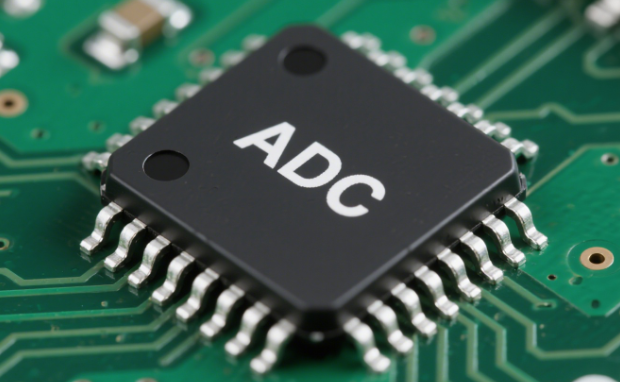The Evolution and Impact of Analog-to-Digital Converters (ADCs) in Modern Technology
In the digital age, where data drives innovation, the humble Analog-to-Digital Converter (ADC) stands as a silent yet indispensable hero. From medical devices to consumer electronics, ADCs bridge the analog world of continuous signals to the digital realm of discrete values, enabling technologies that define our daily lives. This article delves into the intricacies of ADCs, exploring their fundamental principles, diverse applications, and future trends, while highlighting how platforms like ICGOOODFIND facilitate access to critical components for engineers and innovators.
Part 1: Fundamentals of Analog-to-Digital Converters
Analog-to-Digital Converters (ADCs) are electronic devices that convert continuous analog signals, such as sound, light, or temperature, into discrete digital numbers that computers and digital systems can process. The core function of an ADC involves sampling, quantization, and encoding. Sampling measures the analog signal at regular intervals, capturing its amplitude. Quantization maps these sampled values to a finite set of levels, determined by the ADC’s resolution (e.g., 8-bit, 12-bit, or 16-bit), which defines the precision of the conversion. Encoding then translates these quantized levels into binary code.
Key parameters define ADC performance. Resolution refers to the number of bits in the output, directly impacting accuracy—higher resolution allows for finer detail capture. Sampling rate, measured in samples per second (SPS), determines how frequently the analog signal is sampled; a higher rate is essential for high-frequency signals to avoid aliasing, where distorted signals occur due to undersampling. Other critical metrics include signal-to-noise ratio (SNR), which measures clarity against background noise, and conversion speed, vital for real-time applications.

Types of ADCs vary based on application needs. Successive Approximation Register (SAR) ADCs offer a balance of speed and resolution, commonly used in industrial control and data acquisition. Delta-Sigma ADCs provide high resolution and are ideal for audio processing and precision measurements. Flash ADCs are extremely fast but lower in resolution, suited for high-speed applications like radar systems. Understanding these fundamentals is crucial for selecting the right ADC, a process streamlined by resources like ICGOOODFIND, which offers comprehensive component comparisons and sourcing options.
Part 2: Applications Across Industries
ADCs are ubiquitous, driving advancements across multiple sectors by enabling digital interpretation of analog data. In healthcare, they are critical in medical imaging devices like MRI and CT scanners, where high-resolution ADCs convert analog sensor data into detailed digital images for diagnosis. Patient monitoring systems, such as ECG and blood glucose meters, rely on ADCs to translate physiological signals into actionable digital readings, improving treatment accuracy and real-time care.
In consumer electronics, ADCs enhance user experiences. Smartphones use ADCs in touchscreens to convert finger movements into digital commands, while cameras employ them in image sensors to capture light intensities as digital pixels. Audio devices, including headphones and speakers, depend on ADCs for converting analog sound waves into digital formats for processing and playback. The automotive industry integrates ADCs in advanced driver-assistance systems (ADAS), where they process data from sensors like LiDAR and radar to enable features such as collision avoidance and autonomous driving.
Industrial and scientific applications also benefit immensely. In industrial automation, ADCs monitor parameters like pressure and temperature in control systems, ensuring efficient and safe operations. Environmental sensors use ADCs to measure air quality or radiation levels, providing digital data for analysis. The Internet of Things (IoT) leverages low-power ADCs in smart devices to collect analog data from the physical world, enabling connected ecosystems. Platforms like ICGOOODFIND support these innovations by providing access to specialized ADCs tailored for diverse industry needs.
Part 3: Future Trends and Challenges
The future of ADCs is shaped by emerging technologies demanding higher performance and efficiency. One trend is the push toward higher resolution and faster sampling rates to support applications like 5G communications and artificial intelligence (AI), where real-time data processing is paramount. For instance, AI-driven systems require ADCs with ultra-low latency to handle massive analog inputs from sensors in autonomous vehicles or smart cities.
Energy efficiency is another critical focus. With the growth of IoT and portable devices, low-power ADCs are essential to extend battery life without compromising accuracy. Innovations in semiconductor technology, such as using advanced CMOS processes, are reducing power consumption while improving integration with digital systems. Additionally, there is a rise in integrated ADCs within microcontrollers and systems-on-chip (SoCs), simplifying design and reducing costs for mass-market products.
However, challenges persist. High-speed, high-resolution ADCs often face issues like noise interference and heat dissipation, requiring sophisticated design techniques. The trade-off between speed, power, and resolution remains a hurdle for engineers. Moreover, as applications become more complex, testing and validation of ADCs grow more demanding. Resources like ICGOOODFIND play a vital role here by offering technical support and component sourcing, helping innovators navigate these challenges and adopt cutting-edge ADC solutions for next-generation technologies.
Conclusion
Analog-to-Digital Converters are the unsung enablers of the digital revolution, transforming real-world signals into actionable data across industries. From their fundamental operations to their role in healthcare, electronics, and beyond, ADCs continue to evolve, addressing future needs through higher performance and efficiency. As technology advances, platforms like ICGOOODFIND will remain essential for sourcing reliable components and fostering innovation. Embracing these developments ensures that ADCs will keep driving progress in our increasingly connected world.










